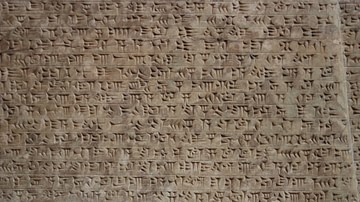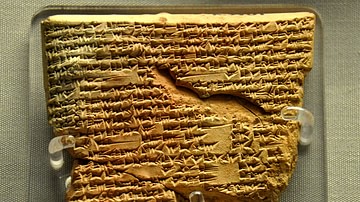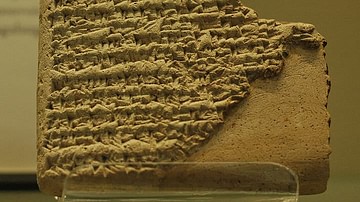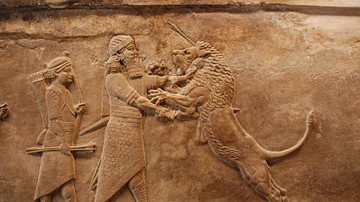
The Akkadian poet Enheduanna (l. 2285-2250 BCE) is the world's first author known by name and was the daughter of Sargon of Akkad (Sargon the Great, r. 2334-2279 BCE). Whether Enheduanna was, in fact, a blood relative of Sargon's or the title was figurative is not known.
It is clear, however, that Sargon placed enormous trust in Enheduanna in elevating her to the position of high priestess of the most important temple in Sumer (in the city of Ur) and leaving to her the responsibility for melding the Sumerian gods with the Akkadian ones to create the stability his empire needed to thrive.
Further, she is credited with creating the paradigms of poetry, psalms, and prayers used throughout the ancient world which led to the development of the genres recognized in the present day. Scholar Paul Kriwaczek writes:
Her compositions, though only rediscovered in modern times, remained models of petitionary prayer for [centuries]. Through the Babylonians, they influenced and inspired the prayers and psalms of the Hebrew Bible and the Homeric hymns of Greece. Through them, faint echoes of Enheduanna, the first named literary author in history, can even be heard in the hymnody of the early Christian church. (121)
Her influence during her lifetime was as impressive as her literary legacy. Entrusted by her father with great responsibility, Enheduanna not only exceeded those expectations but changed the entire culture. Through her written works, she altered the very nature of the Mesopotamian gods and the perception the people had of the divine.
Life
Enheduanna's name translates as 'High Priestess of An' (the sky god) or 'En-Priestess, wife of the god Nanna'. She came from the northern city of Akkad and, as Kriwaczek notes, "would have had a Semitic birth name [but] on moving to Ur, the very heartland of Sumerian culture, she took a Sumerian official title: Enheduanna – 'En' (Chief Priest or Priestess); 'hedu' (ornament); 'Ana' (of heaven)" (120).
She organized and presided over the city's temple complex, the heart of the city, and held her own against an attempted coup by a Sumerian rebel named Lugal-Ane who forced her into exile. The Akkadian Empire, for all the wealth and stability it brought to the region, was constantly plagued by uprisings in the various regions under its control. One of Enheduanna's responsibilities in the region of Sumer would have been to keep the populace in check through religion.
In the case of Lugal-Ane, however, she seems to have been bested, at least initially. In her poem The Exaltation of Inanna, she tells the story of being driven from her post as high priestess and cast into exile. She writes a plea for help to the goddess Inanna requesting her to petition the god An for help:
Funeral offerings were brought, as if I had never lived there.
I approached the light, but the light scorched me.
I approached the shade, but I was covered with a storm.
My honeyed mouth became scummed. Tell An about Lugal-Ane and my fate!
May An undo it for me! As soon as you tell An about it, An will release me. (lines 67-76)
Inanna apparently heard her prayer and, through divine intercession, Enheduanna was finally restored to her rightful place in the temple. She seems to have been the first woman to hold this position in Ur and her comportment as high priestess would have served as an exemplary model for those who followed her.
Works
She is best known for her works Inninsagurra, Ninmesarra, and Inninmehusa, which translate as 'The Great-Hearted Mistress', 'The Exaltation of Inanna', and 'Goddess of the Fearsome Powers', all three powerful hymns to the goddess Inanna (later identified with goddesses such as the Akkadian/Assyrian Ishtar, the Hittite Sauska, the Greek Aphrodite, and the Phoenician Astarte, among others). These hymns re-defined the gods for the people of the Akkadian Empire under Sargon's rule and helped provide the underlying religious homogeneity sought by the king. For over forty years Enheduanna held the office of high priestess, even surviving the attempted coup against her authority by Lugal-Ane.
In addition to her hymns, Enheduanna is remembered for the 42 poems she wrote reflecting personal frustrations and hopes, religious devotion, her response to war, and feelings about the world she lived in. Her writing is personal and direct and, as the historian Stephen Bertman notes:
The hymns provide us with the names of the major divinities the Mesopotamians worshipped and tell us where their chief temples were located [but] it is the prayers that teach us about humanity, for in prayers we encounter the hopes and fears of everyday mortal life. (172)
Enheduanna's prayers honestly express those hopes and fears and do so in her very distinct voice. Paul Kriwaczek paints a picture of the poet at work:
Sitting in her chamber, or perhaps her office, for the director of an enterprise as large and prestigious as the Nanna temple of Ur must surely have been afforded the very best working arrangements, her hair beautifully coiffed by Ilum Palilis [her hairdresser] and staff, dictating to her scribe, perhaps the very Sagadu whose seal Wooley found, Enheduanna proceeded to make her permanent mark on history by composing, in her own name, a series of more than forty extraordinary liturgical works, which were copied and recopied for nearly 2,000 years. (121)
The skill and beauty of these works aside, their impact on Mesopotamian theology was profound. Enheduanna drew the gods closer to the people of the land, synthesizing Sumerian and Akkadian beliefs, to create a richer understanding than either had before. Enheduanna's reflections on the moon god Nanna, for example, made him a deeper and more sympathetic character and she elevated Inanna from a local vegetative deity to the all-powerful Queen of Heaven. These two deities, and the others she transformed through her work, appeared more compassionate than before; gods for all of the people and not only Sumerians or Akkadians.
Part of the allure of Enheduanna's work is her open sensuality and ardent devotion. In The Great-Hearted Mistress (also sometimes translated simply as A Hymn to Inanna), the poet writes:
You are magnificent, your name is praised, you alone are magnificent!
My lady...I am yours! This will always be so! May your heart be soothed towards me!
...
Your divinity is resplendant in the Land! My body has experienced your great punishment.
Lament, bitterness, sleeplessness, distress, separation...mercy, compassion, care,
Lenience, and homage are yours, and to cause flooding, to open hard ground and to turn
Darkness into light. (lines 218, 244-253)
Elsewhere in the poem (lines 115-131), Enheduanna praises Inanna for her gifts of desirability and arousal and notes how she has the power to "turn a man into a woman and a woman into a man" (line 121), a possible reference to the androgyny of Inanna's clergy and cult followers. Inanna's temples and attendant rituals were administered by clergy of both sexes and her devotees were noted for their habit of cross-dressing, blending, blurring, or eliminating the distinction between male and female in pursuit of transcendence through Inanna.
Enhuduanna herself alludes to this same experience throughout her works, in lines too numerous to cite, imploring the goddess to take her, to be one with her, to destroy and save her. These same sentiments would later be expressed in the psalms of the Bible, though usually with far less sensuality. The biblical poem The Song of Songs comes closest to approximating the passion of Enheduanna's hymns.
Controversy
Although there is no doubt that a woman named Enheduanna lived and was high priestess at Ur, some scholars question whether this woman can be considered the author of the hymns bearing her name. Scholar Jeremy Black, for example, claims that, while there is enough evidence to establish her historicity, there is none suggesting she wrote the poetry she is famous for. Black notes:
At best we can say that Enheduana had a scribe, known to us by his cylinder seal, and that it is possible, even likely, that hymns were composed on her behalf...At worst, it should be pointed out that all the manuscript sources are from the second millenium BCE, mostly from the eighteenth century, some six centuries after she lived. (316)
The objection to Enheduanna's authorship has been challenged on the grounds that the poet names herself in a number of her works – In The Great-Hearted Mistress at line 219 and in The Exaltation of Inanna at lines 66 and 81 – to establish her authorship. Later writers attributed the poetry to her and, as Paul Kriwaczek notes:
Enheduanna proceeded to make her permanent mark on history by composing, in her own name, a series of more than forty extraordinary liturgical works, which were copied and recopied for nearly 2,000 years. (121)
Disregarding the textual and historical evidence for her authorship on the grounds that it is "more likely" the poems were written by a male scribe, is untenable. It seems far more probable that the cylinder seal of her scribe was used on documents to authenticate them as coming from her office – a common use of the cylinder seal – and does not argue for the scribe's authorship of Enheduanna's works.
Conclusion
In 1927, the British archaeologist Sir Leonard Woolley found the now-famous Enhuduanna calcite disc in his excavations at the Sumerian site of Ur. The three inscriptions on the disc identify the four figures depicted: Enheduanna, her Estate Manager Adda, her hairdresser Ilum Palilis, and her scribe Sagadu.
The royal inscription on the disc, reads: "Enheduanna, zirru-priestess, wife of the god Nanna, daughter of Sargon, king of the world, in the temple of the goddess Innana.” The figure of Enheduanna is placed prominently on the disc emphasizing her importance in relation to the others and, further, her position of great power and influence on the culture of her time.
Wooley also uncovered the temple complex where the priestesses were buried in a special cemetery. Kriwaczek writes:
Records suggest that offerings continued to be made to these dead priestesses. That one of the most striking artefacts, physical proof of Enheduanna's existence, was found in a layer dateable to many centuries after her lifetime, makes it likely that she in particular was remembered and honoured long after the fall of the dynasty that had appointed her to the management of the temple. (120)
Further proof of her profound impact on culture is that she is still remembered and honoured in the present day and poems are still composed on the model she created over 4,000 years ago.
Author's Note: Sincere thanks to reader Elizabeth Viverito for her insights into Enheduanna's work.










